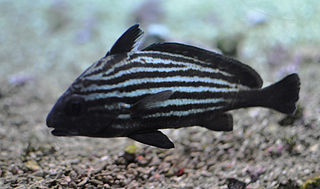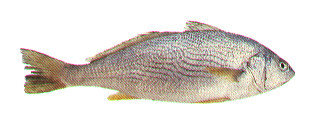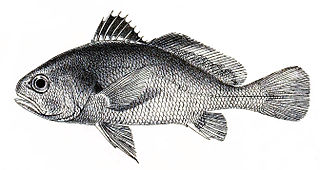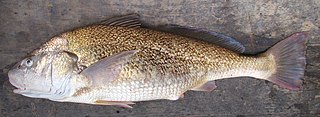
Sciaenidae is a family of ray-finned fishes belonging to the order Acanthuriformes. They are commonly called drums or croakers in reference to the repetitive throbbing or drumming sounds they make. The family consists of about 293 to 298 species in about 66 or 67 genera.

Micropogonias is a genus of marine ray-finned fishes belonging to the family Sciaenidae, the drums and croakers. These fishes are found in the eastern Pacific and western Atlantic Oceans.
The striped croaker, also known as the St Lucian corvina, is a species of marine ray-finned fish belonging to the family Sciaenidae, the drums and croakers. This species is found in the western Atlantic Ocean in the Caribbean Sea and Gulf of Mexico.

Cynoscion is a genus of marine ray-finned fishes belonging to the family, Sciaenidae, the drums and croakers. These fishes are found off the coasts of North and South America in the western Atlantic and eastern Pacific Oceans. Many fishes in this genus have been given the common name weakfish.

Pareques acuminatus, commonly known as the high-hat, donkeyfish, cubbyu, Steindachner's ribbonfish, streaked ribbonfish, striped ribbonfish or striped drum, is a species of marine ray-finned fish belonging to the genus Pareques in the family Sciaenidae, the drums and croakers. This species is found in the western Atlantic Ocean.

Larimichthys is a genus of marine ray-finned fishes belonging to the family Sciaenidae, the drums and croakers. These fishes, commonly known as yellow croakers, are found in the Western Pacific Ocean.

Nebris is a small genus of marine ray-finned fishes belonging to the family Sciaenidae, the drums and croakers. There are two species in the genus, one in the Western Atlantic Ocean and one in the Eastern Pacific Ocean.

Corvula is a genus of marine ray-finned fishes belonging to the family Sciaenidae, the drums and croakers. These fishes are found in the western Atlantic Ocean and the central eastern Pacific Ocean.

Bairdiella is a genus of marine ray-finned fishes belonging to the family Sciaenidae, the drums and croakers. These fishes are found in the western Atlantic and eastern Pacific Ocean.

Umbrina is a genus of fish from the croaker family Sciaenidae. The genus contains 17 species occurring in tropical and warm temperate waters of the Atlantic, the Mediterranean, the Western Indian Ocean and the eastern Pacific.

The geelbeck croaker, also known as the African weakfish or Cape salmon, is a species of marine ray-finned fish belonging to the family Sciaenidae, the drums and croakers. This species is found in the southwestern Indian Ocean off southeastern Africa.
Atractoscion atelodus, the small lunate caudal fin croaker, teraglin, Jew, teraglin-Jew, trag or trag-Jew, is a species of marine ray-finned fish belonging to the family Sciaenidae, the drums and croakers. This species is endemic to the eastern coast of Australia.

Isopisthus is a genus of marine ray-finned fishes belonging to the family Sciaenidae, the drums and croakers. These fishes are found in the western Atlantic and eastern Pacific Oceans.

Johnius dussumieri, the sin croaker, Dussumier's croaker, Dussumier's silver jewfish, sharptooth hammer croaker or whiskered croaker, is a marine ray-finned fish belonging to the family Sciaenidae, the drums and croakers. This fish is found in the Indian Ocean.

Johnius carutta, the karut croaker or purple jewfish, is a species of marine ray-finned fish belonging to the family Sciaenidae, the drums and croakers. This species is found in the western Indian Ocean.

The kathala croaker is a species of marine ray-finned fish belonging to the family Sciaenidae, the drums and croakers. This species is found in the Indian Ocean off South Asia. It is the only species in the monospecific genus Kathala.

Larimus is a genus of marine ray-finned fishes belonging to the family Sciaenidae, the croakers and drums. These fishes are found in the Western Atlantic and Eastern Pacific Oceans.

The cuja bola is a species of marine ray-finned fish belonging to the family Sciaenidae, the drums and croakers. This fish is found in the northern Indian Ocean in India, Bangladesh, Myanmar and Thailand. It is the only species in the monospecific genus Macrospinosa.

Micropogonias furnieri, the whitemouth croaker, golden croaker, hardhead, mangrove snapper, rocandoronco, two-belly bashaw, West Indian croaker, West Indian drum or whitemouth drummer, is a species of marine ray-finned fish belonging to the family Sciaenidae, the drums and croakers. This fish is found in the western Atlantic Ocean.

Odontoscion is a genus of marine ray-finned fish belonging to the family Sciaenidae, the croakers and drums. These fishes are found in the Western Atlantic and Eastern Pacific Oceans.


















